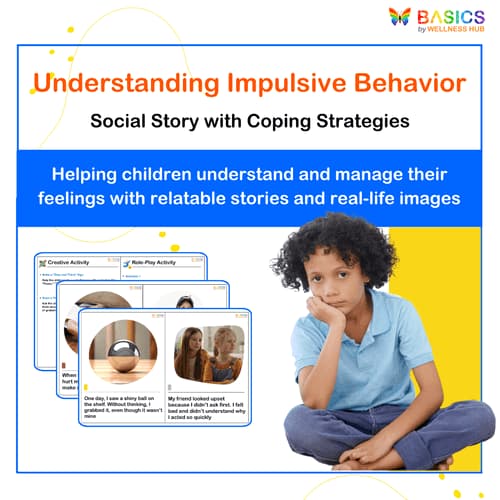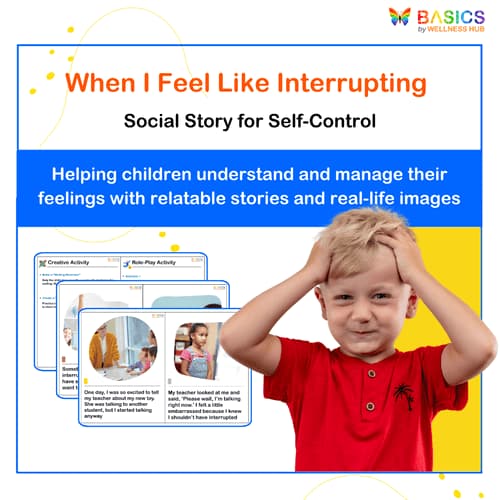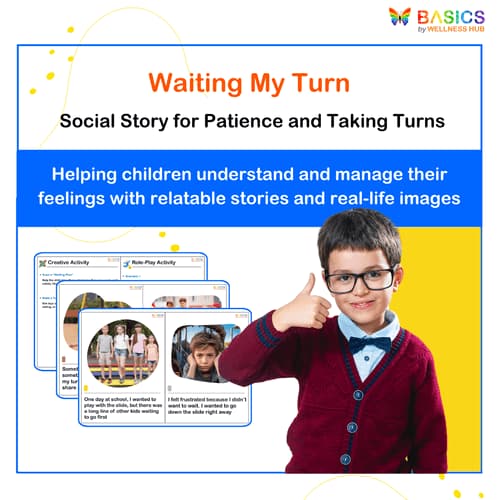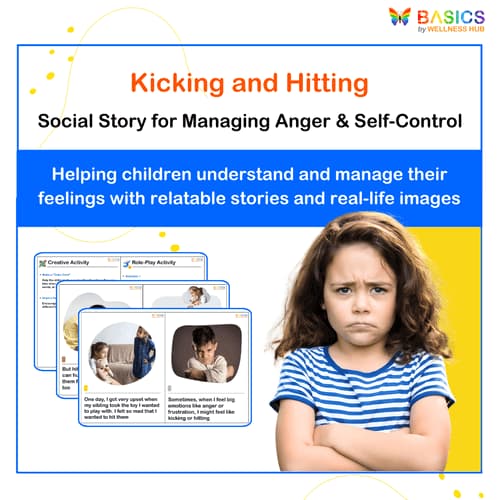





Conversation Cards - Simple Stories and Fairy Tales: Encouraging Imaginative Thinking and Storytelling
₹80
₹160
50% off
0 (0 ratings)
Grade Levels
Pre-K - Grade 2 (Ages 4-7)
Content Overview
Format: PDF download Total Number of Pages: 3 pages, 24 prompts Features: Prompts designed to enhance storytelling and imagination skills
Categories
Pages from the Resource
These conversation cards are perfect for sparking imaginative storytelling in children! With 24 carefully crafted prompts focusing on fairy tales and simple stories, this resource encourages children to explore creativity, develop language skills, and build confidence in verbal expression. Ideal for classrooms, therapy sessions, or family playtime.

Page 1

Page 2
What Users Say
0
0 ratings
5
0+
4
0+
3
0+
2
0+
1
0+
5 Stars
Product is Good to use.
9 months ago
Varsha Parent
Similar Products

Understanding Impulsive Behavior: Social Story with Coping Strategies
₹ 80.00
₹ 160.00
50% off
4.9 (42 ratings)

When I Feel Like Interrupting – Social Story for Self-Control
₹ 80.00
₹ 160.00
50% off
4.8 (60 ratings)

Waiting My Turn – Social Story for Patience and Taking Turns
₹ 80.00
₹ 160.00
50% off
4.7 (56 ratings)

Kicking and Hitting – Social Story for Managing Anger & Self-Control
₹ 80.00
₹ 160.00
50% off
4.6 (52 ratings)

Understanding Swear Words – Social Story for Respectful Communication
₹ 80.00
₹ 160.00
50% off
4.9 (48 ratings)
About the Product
Purpose of Flashcards: The "Conversation Cards - Simple Stories and Fairy Tales" resource is designed to spark creativity and enhance language skills in children by encouraging them to think, imagine, and express their thoughts. These cards provide fun, open-ended prompts that invite children to explore classic fairy tales, create their own stories, and dive into imaginative scenarios. Perfect for building communication skills, social-emotional learning, and creative thinking, this resource is ideal for parents, teachers, and therapists working with young learners.

Product Details
Format: PDF Download
Total Pages: 3 pages
Number of cards: 24 conversation prompts/questions
Content: Each card contains a high-quality image paired with a fairy tale or imaginative prompt. The prompts are carefully crafted to suit children’s cognitive levels while also encouraging them to think creatively and share their ideas.
Educational Benefits
Language Development: The prompts help children practice their language skills by encouraging them to construct sentences, use descriptive words, and articulate their thoughts clearly.
Imagination and Creativity: These conversation cards engage children’s imagination as they create their own versions of fairy tales, imagine new characters, and think about what happens next in a story.
Social-Emotional Learning (SEL): By discussing characters, scenarios, and lessons in stories, children learn about empathy, decision-making, and different perspectives, all of which are vital components of social-emotional growth.
Critical Thinking: The resource promotes critical thinking by prompting children to consider what makes a good story, how they would react in certain situations, and how they can solve problems within their imaginative worlds.
Instructions for Use
Select the Setting: These cards can be used in both one-on-one settings and group activities. Choose a comfortable space where the child feels relaxed and ready to share their thoughts.
Introduce the Concept: Start by explaining what a fairy tale or imaginative story is, discussing a few familiar examples like “Cinderella” or “Jack and the Beanstalk.”
Present the Cards: Show one card at a time, reading out the prompt and encouraging the child to think about their answer before speaking. Allow them time to fully develop their ideas.
Encourage Storytelling: For older or more advanced children, invite them to elaborate on their answers by expanding the story or adding more details.
Follow-Up Questions: After the child responds to the prompt, ask additional questions to deepen their thinking. For example, if the child mentions a favorite character, ask why they like that character or how the character could be part of a new adventure.
Incorporate Role Play:Encourage the child to act out their stories or imagine they are one of the characters. This not only enhances their engagement but also supports the development of both verbal and non-verbal communication skills.
Repeat and Rotate: Use the cards regularly to reinforce language skills, introducing different prompts each time to maintain variety and interest.
Activities Using the Resource
Storytelling Circle: Arrange a small group of children in a circle. Pass a card around and let each child add one sentence to a collective story based on the prompt. This activity encourages cooperation, active listening, and creativity. It’s also adaptable for larger groups, where each child gets a turn to continue the narrative.
Character Creation: After reading a prompt, challenge the child to create their own fairy tale character based on the story idea. They can describe what the character looks like, their personality, and what role they play in the story. This activity helps enhance descriptive language skills and imaginative thinking.
Role-Playing: Use the cards as inspiration for role-play. Children can take on different roles, acting out scenes from the stories they imagine. This activity not only strengthens social skills but also improves non-verbal communication, such as facial expressions and body language.
Drawing and Illustrating Stories: After discussing a card, encourage the child to draw scenes or characters from the story they created. This activity integrates visual arts with literacy, allowing children to express their ideas both verbally and artistically.
Story Mapping: Use the conversation cards to help children map out the sequence of events in a story. They can arrange the cards in an order that tells a logical narrative, fostering an understanding of story structure, including beginnings, middles, and endings.
Fairy Tale Mashup: Mix characters or elements from different fairy tales to create a brand-new story. For example, what happens if Jack from "Jack and the Beanstalk" meets Cinderella? This activity encourages out-of-the-box thinking and boosts creativity.
FAQs
Q1: At what age are these conversation cards most appropriate?
A1: These cards are suitable for children aged 4 to 8 years. They are versatile and can be adapted to various developmental levels, making them an effective tool for preschoolers, early learners, and even older children who enjoy storytelling.
Q2: How often should I use these cards with my child?
A2: The frequency depends on your child’s engagement level. Incorporating them into daily routines, such as before bedtime or during playtime, works well. You can also use them during group activities or special story sessions once or twice a week.
Q3: Can these cards be used with children who are non-verbal or minimally verbal?
A3: Yes, even non-verbal or minimally verbal children can benefit from these cards. You can use the visual prompts to encourage non-verbal communication, such as pointing, gesturing, or even drawing responses.
Q4: How do these cards help with language development?
A4: The prompts encourage children to think about language structure, expand their vocabulary, and practice constructing sentences. Discussing characters, actions, and settings supports a deeper understanding of language use.
Q5: Are these cards suitable for group activities?
A5: Absolutely! These cards are great for group settings such as classrooms, therapy sessions, or family gatherings. They foster teamwork, communication, and creative thinking when used in a group.
Usage Rights and Restrictions
Personal Use: These conversation cards are intended for personal use by the purchaser. They can be used at home, in classrooms, or in therapy settings, but they may not be shared with other individuals or groups outside of the purchaser’s immediate circle.
Commercial Use: The cards cannot be reproduced, distributed, or sold in any commercial capacity. Redistribution or sharing of the digital file is strictly prohibited.
Copying and Distribution: Copying, altering, or sharing the digital file or printed copies with others without permission is not allowed. If additional copies are needed for a larger group or multiple classes, additional licenses should be purchased.
Conclusion
The "Conversation Cards - Simple Stories and Fairy Tales" resource is a versatile and engaging tool for fostering creativity, language development, and imaginative play. Whether you’re a parent looking to bond with your child through storytelling, a teacher enhancing literacy skills, or a therapist encouraging communication, these cards provide endless opportunities for meaningful interaction. Thank you for choosing this resource; we hope it brings many delightful and educational moments for you and your learners.



